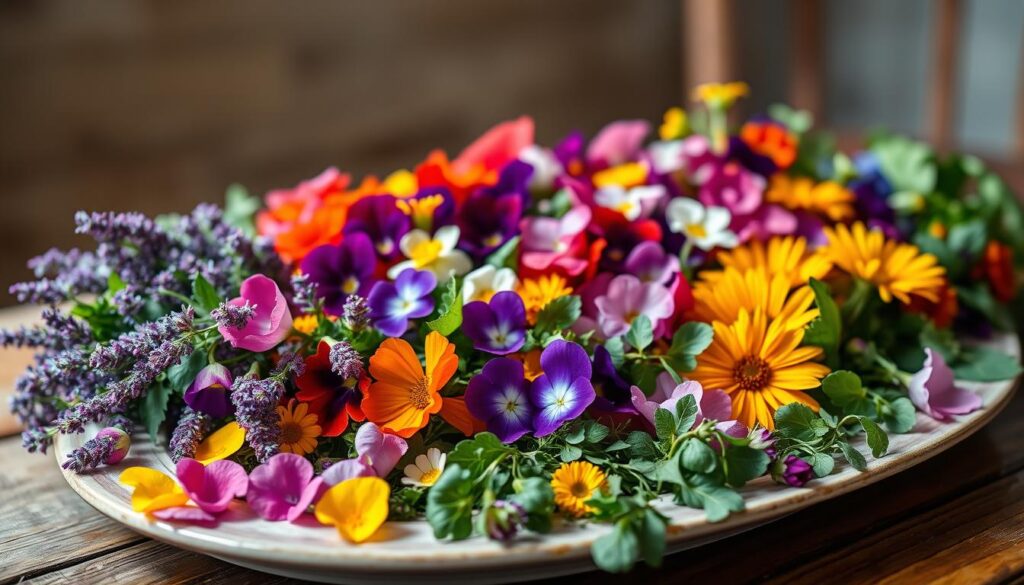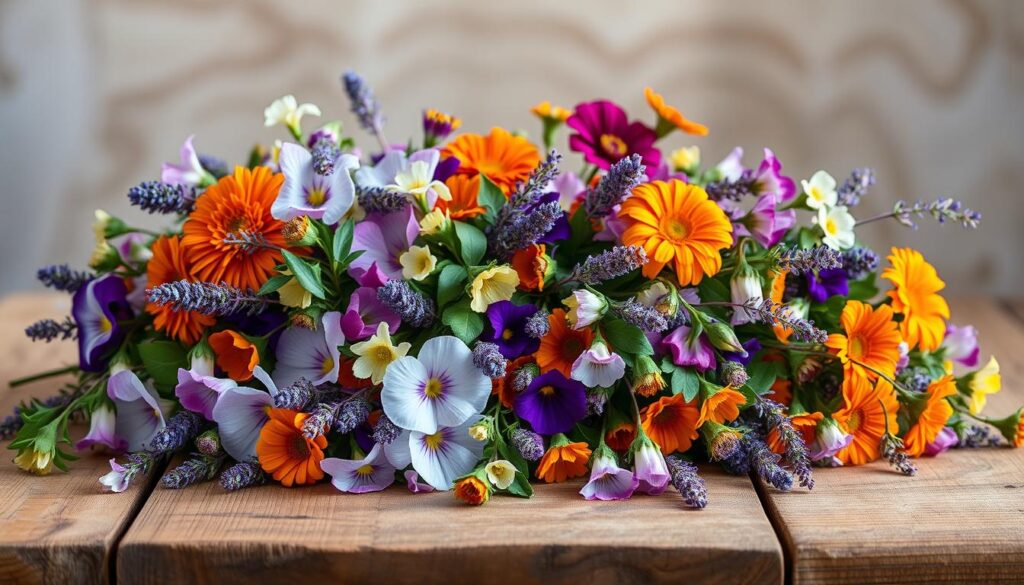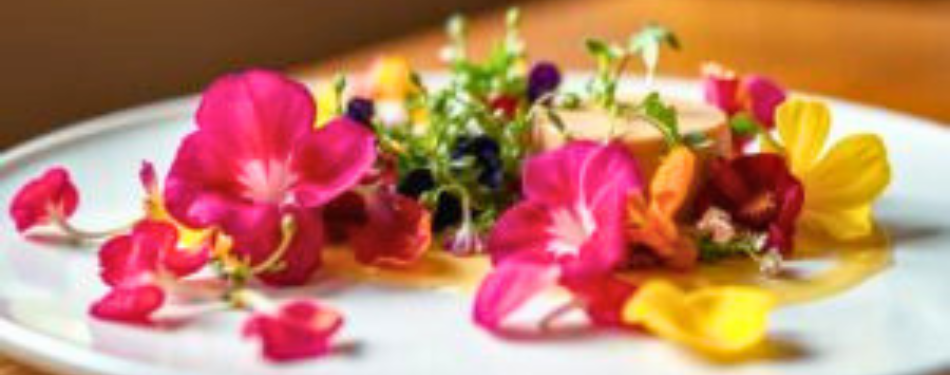Organic edible flowers are becoming a big deal in fine dining. They make dishes look better and taste even better. This makes eating out a special treat.
Restaurants are now choosing organic flowers because they are good for you. This choice makes meals both fancy and healthy. Chefs use these flowers to create new and exciting dishes.
This trend shows that fine dining is changing. It’s not just about fancy food anymore. It’s about using ingredients that are good for you and the planet.
Key Takeaways
- Organic edible flowers add aesthetic and flavor to fine dining.
- Using pesticide-free blooms aligns with health-conscious dining trends.
- Many chefs are innovating by incorporating organic flowers.
- Organic ingredients enhance the overall culinary experience.
- Fine dining is increasingly embracing organic and responsible choices.
The Allure of Organic Edible Flowers
Organic edible flowers are stunningly beautiful. They come in bright colors that catch your eye. Each flower has its own shape and color, making food look amazing.
These flowers are not just pretty. They also have unique tastes and smells. They make food more interesting to eat.
In cooking, these flowers add something special. They can make food taste sweet or savory. This makes meals unforgettable.
Seasonal flowers make cooking even more fun. They let chefs try new things. This celebrates the beauty of nature.
Many cultures use edible flowers in their food. This shows a wide range of tastes and traditions. It makes these flowers even more special.
These flowers are good for more than just looks. They are also healthy and sustainable. They make any meal better.
The Benefits of Organic Edible Flowers
Organic edible flowers are great for meals. They help us stay healthy. They are full of vitamins and antioxidants.
These flowers also help the planet. They support sustainable farming.
Health Benefits of Choosing Organic
Organic flowers are safe from bad chemicals. They make us and the earth healthier.
Flowers like nasturtiums and violets are full of vitamins A and C. They boost our immune system.
They also have antioxidants. These fight off bad stuff in our bodies.
By eating organic, we make our food better. We also help the planet.
Environmental Impact of Organic Farming
Organic farming is good for the earth. It keeps the soil healthy and supports many living things.
It also helps pollinators like bees. These are important for growing food.
Choosing organic flowers helps our planet. It makes farming better for the future.
Why Organic Edible Flowers Are a Must for Fine Dining
Fine dining with organic flowers is becoming more popular. Chefs and food lovers are adding these flowers to dishes. They make food look great and taste amazing.
Restaurants that use local and organic ingredients are leading the way. They know organic flowers make food look better. They also meet the needs of people who care about their health.
Organic edible flowers tell a story that diners love. People want to know where their food comes from. Restaurants that use these flowers show they care about the planet.
| Aspect | Traditional Flowers | Organic Edible Flowers |
|---|---|---|
| Nutritional Value | Unknown origin and possible additives | Full of vitamins, minerals, and antioxidants |
| Sustainability | Pesticides are often used a lot | Supports green farming methods |
| Flavor Complexity | May not have strong flavors | Brings unique tastes to dishes |
| Customer Appeal | Often seen in meals | Appeals to those who value health and looks |
Culinary Uses of Edible Flowers
Edible flowers are more than just pretty faces. They add flavor and color to our food. Chefs and home cooks love using them to make dishes pop.
Enhancing Visual Appeal
Edible flowers come in bright colors and cool shapes. They turn simple dishes into stunning works of art. Just a few nasturtiums can brighten up a salad.
Try adding violets to your desserts for a fancy touch. These flowers make food look and taste amazing.
Flavor Profiles and Pairings
Each edible flower has its own taste. Lavender is sweet and herbal, perfect for sweets. Arugula flowers add a peppery kick to salads and seafood.
When you mix these flowers with the right foods, you get a feast for all senses. It’s a fun way to explore new flavors and impress your guests.

Incorporating Organic Flowers in Dishes
Adding organic flowers to your dishes makes them more exciting. Choose fresh, organic flowers like nasturtiums, pansies, and violets. They can make your recipes better.
First, wash the flowers gently with cold water. This removes dirt and pesticides. It keeps their colors bright and flavors mild.
Think about what goes well together. Nasturtiums are great in salads for their peppery taste. Violets are perfect for desserts like cakes or ice creams. Chive blossoms add a mild onion flavor to savory dishes.
Keeping the flowers fresh is important. Store them in a sealed container with a damp paper towel. This keeps them moist without getting soggy.
Don’t be afraid to try new things. Organic flowers can be used in drinks or as garnishes. They add a creative touch to your cooking.
Creating Stunning Organic Floral Arrangements
Making beautiful organic floral arrangements makes any dish look amazing. It’s more than just putting flowers on a plate. It’s about art and choosing the right flowers. Learning how to present them can make a meal special.
Tips for Presentation
Here are some tips for arranging organic flowers:
- Color Harmony: Pick flowers that match the dish’s colors. Bright ones add excitement, while soft ones bring elegance.
- Height Variations: Use flowers of different heights for depth. Tall ones draw attention, and short ones fill gaps.
- Use Edible Foliage: Add leaves and greens that you can eat. This keeps the arrangement organic.
- Natural Patterns: Make the flowers look like they grew naturally. Organic arrangements should look easy and flowing.
Seasonal Flower Selection
Knowing when to pick flowers is key. Picking flowers in season means they’re fresh and taste great. Here are some popular choices by season:
| Season | Flowers Available | Flavor Notes |
|---|---|---|
| Spring | Lavender, Pansies, Violas | Sweet, Delicate |
| Summer | Chamomile, Nasturtium, Zinnias | Spicy, Refreshing |
| Fall | Hibiscus, Marigold, Sunflower | Earthy, Warm |
| Winter | Winter Jasmine, Holly, Winterberry | Bright, Tart |

Organic Edible Flower Recipes to Try
Exploring organic edible flower recipes opens a world of creativity. It can make any dish special. From salads with colorful petals to desserts with floral tastes, organic flowers add beauty and flavor. Let’s explore some fun ideas!
Salad Enhancements with Edible Flowers
Make your salads pop with stunning edible flowers. Here’s a simple recipe:
- Ingredients:
- Mixed greens (arugula, spinach, and kale)
- Edible flowers (nasturtiums, pansies, or violets)
- Cherry tomatoes, halved
- Cucumber, thinly sliced
- Feta cheese, crumbled
- Olive oil and balsamic vinegar for dressing
- Instructions:
- In a large bowl, mix the greens and veggies.
- Add edible flowers just before serving.
- Drizzle with olive oil and balsamic vinegar.
- Enjoy a fresh salad that’s full of color and taste.
Creative Desserts Featuring Flowers
Sweets can be magical with flowers. Try this flower-infused panna cotta recipe:
- Ingredients:
- 2 cups heavy cream
- 1 cup whole milk
- 1/2 cup sugar
- 1 tablespoon gelatin powder
- Edible flowers (lavender and rose petals)
- Instructions:
- In a saucepan, mix cream, milk, and sugar. Heat until sugar melts.
- Add gelatin and let it bloom for a few minutes.
- Stir in the flowers.
- Pour into glasses and chill until firm.
- Top with more flowers for a beautiful dessert.
Edible Flower Garden Tips
Starting an edible flower garden is fun and rewarding. Knowing the basics helps a lot. Pick different types of flowers that fit your area’s weather. Nasturtiums, pansies, and marigolds are great because they taste good and look bright.
Make sure your garden gets lots of sunlight. Most edible flowers need at least six hours of sun a day. Also, leave enough space between plants for air to move around. This helps prevent sickness.
Water your garden well but not too often. This makes the roots strong. It’s a key part of taking care of your garden.
Keep your garden clean by removing dead flowers and sick leaves. Use natural fertilizers to help your plants grow. This keeps your garden healthy and beautiful.
If you don’t have a lot of space, don’t worry. You can grow edible flowers in pots on balconies or patios. Pick small plants or ones that spread out. This is good for the planet and lets you grow more flowers at home.
| Flower Variety | Sunlight Needs | Flavor Profile |
|---|---|---|
| Nasturtium | Full Sun | Spicy, peppery |
| Pansy | Partial Sun | Sweet, mild |
| Marigold | Full Sun | Earthy, citrus |
| Chive Blossom | Full Sun | Onion-like |
| Bee Balm | Full Sun | Minty, herbal |
Creating an edible flower garden is not just for food. It’s also about connecting with what you eat. Enjoy the journey, and you’ll get to enjoy many tasty flowers in your cooking.
Conclusion
Adding organic edible flowers to your food makes it look and taste better. They are good for you and the planet. These flowers can make salads and desserts more exciting.
Choosing organic edible flowers is good for your health and the earth. They make food more enjoyable and help farmers grow food in a green way. This choice helps our planet and supports many plants and animals.
Let organic edible flowers spark your cooking ideas. They can make your dishes special and impress your guests. Start exploring and see how these flowers can make your food amazing!





